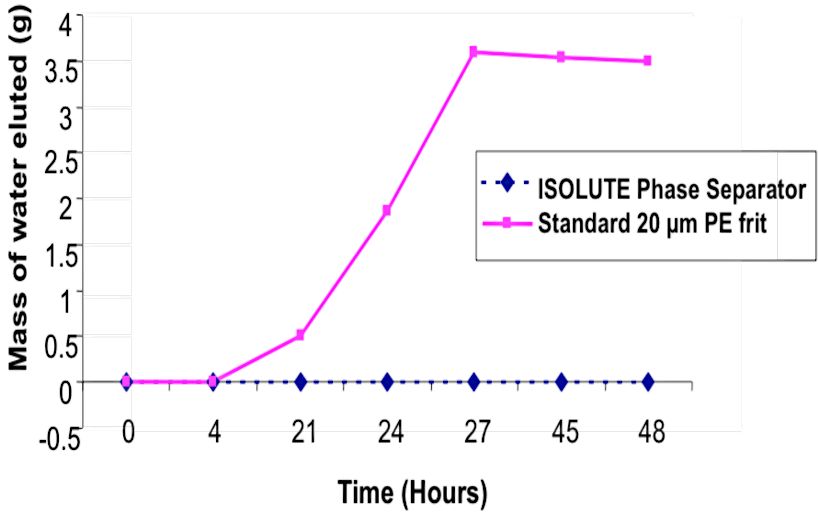ISOLUTE Phase Separators
More efficient than traditional glass separating funnels
Phase separators are a range of ISOLUTE® columns fitted with a selectively permeable, optimized frit material that separates aqueous phase from chlorinated solvents under gravity.
| Ordering Information |
| Part # |
Description |
Qty.
|
| ISOLUTE Phase Separator Columns |
| 120-1901-A |
ISOLUTE Phase Separators, 1mL |
100
|
| 120-1903-B |
ISOLUTE Phase Separators, 3mL |
100
|
| 120-1903-BG |
ISOLUTE Phase Separators, 3mL, tab-less |
100
|
| 120-1905-C |
ISOLUTE Phase Separators, 6mL |
100
|
| 120-1905-CG |
ISOLUTE Phase Separators, 6mL, tab-less |
100
|
| 120-1906-D |
ISOLUTE Phase Separators, 15mL |
100
|
| 120-1907-E |
ISOLUTE Phase Separators, 25mL |
100
|
| 120-1908-F |
ISOLUTE Phase Separators, 70mL |
50
|
| 120-1908-F-BL |
ISOLUTE Phase Separators, 70mL, c/w Bar Code Label |
50
|
| 120-1909-J |
ISOLUTE Phase Separators, 150mL |
25
|
| |
| ISOLUTE Phase Separator Fixed-well Plates |
| 120-1910-P01 |
ISOLUTE Phase Separators, Fixed-well plate |
1
|
| 120-1910-P05 |
ISOLUTE Phase Separators, Fixed-well plate |
5
|
|
|
| ISOLUTE Array Phase Separator Wells |
| 120-1920-R |
ISOLUTE Phase Separators, Array well, 1mL |
100
|
| 120-1920-RP |
ISOLUTE Phase Separators, Array well plate, 1mL |
1
|
| 120-1920-T |
ISOLUTE Phase Separators, Array well, 2mL |
100
|
| 120-1920-TP |
ISOLUTE Phase Separators, Array well plate, 2mL |
1
|
Ready-to-use
There are no moving parts, nothing to prime, its all achieved by hydrophobic/hydrophilic interactions, the cartridges arrive ready to use and are compatible with a wide variety of solvents.
How Phase Separators Work
The compound is partitioned, due to differences in solubility, between two immiscible liquids. The lower organic phase can pass through the frit, the upper aqueous phase physically cannot. There is an automatic cut-off at the organic/aqueous interface.
Reasons customers choose Phase Separators
GREEN: ISOLUTE Phase Separators comply with 6 key principles of Green Chemistry* - prevent excess lab waste, maximize atom economy, facilitate use of safer chemicals and products, and utilize less hazardous chemical synthesis, increase energy efficiency, and minimize the potential for accidents.
COST: The life-time cost of a glass sep-funnel can average around $150. Also, itis easy to use more solvent than necessary when washing and it is tempting to over-extract. All this means the cost of chlorinated solvent (approx 2-3 washes, of 50-100mL, over 20 uses) is typically higher than it needs to be. Compare this to phase separators. With Phase Separators, there is no cleaning after use. They're disposable. ( av?1.5 or $3 per experiment (overall 10-25% of the cost of using sep funnels).
EFFICIENCY: Save time, reduce solvent, ISOLUTE Phase Separator tubes are easier to store than glass sep funnels, and are geometrically designed to line up on a FlashVac or rack system, thus enabling the chemist to carry out multiple extractions in parallel. After-use, there is no need to waste valuable time and detergent / solvent, by re-washing, the disposable format allows for a very fast turn around and cycle time for further exactions.
RELIABILITY: Unlike other competitive products such as hydrophobic filter plates or papers, water will not break through. Biotage dye tests (Figure 1) and also customer testimonial have shown that the ISOLUTE Phase Separators are robust and efficient. ISOLUTE Phase Separators are designed to stand alone, working by unattended operation. The upper aqueous phase cannot pass through the frit, so it is not necessary to manipulate the tap for a clean cut. Just open the lower tap*** and walk away, the cut off is automatic.

Figure 1: The effectiveness of ISOLUTE Phase Separators and standard 20 µm PE frits in the separation of aqueous/dichloromethane mixtures. A suspension or emulsion may be left overnight without risk of breakthrough.
Representative Procedure
Weigh 10-20 mg of the dye (trisodium 3-hydroxy-4- (4-sulfonato-1-naphthylazo)-2,7 naphthalenedisulfonate), Figure 2, into a 20 mL glass screw cap vial. Add water (5-7mL) and DCM (5-7mL). Replace screw cap and wrap in lab film. Shake vial to dissolve red dye and thoroughly mix contents. Allow to settle, open vial, pour contents into 25mL ISOLUTE Phase Separator, cited on a FlashVac, using a suitably sized (test tube, minimum 10mL volume) as a collection vessel. Allow time for the 2 layers to separate (1-3 minutes, or leave overnight). The lower layer will be the colorless, translucent DCM layer, and the upper layer will be intensely colored aqueous phase. Open the stopcock under the phase separator and allow draining under gravity. The DCM layer will pass though, leaving the red aqueous layer retained on the separator. Breakthrough of the aqueous layer under gravity will not occur for at least 1 week under normal lab conditions.

Figure 2: Trisodium 3-hydroxy-4-(4-sulfonato-1-naphthylazo)- 2,7-naphthalenedisulfonate (water soluble) red dye used in phase separation demonstrations
|



